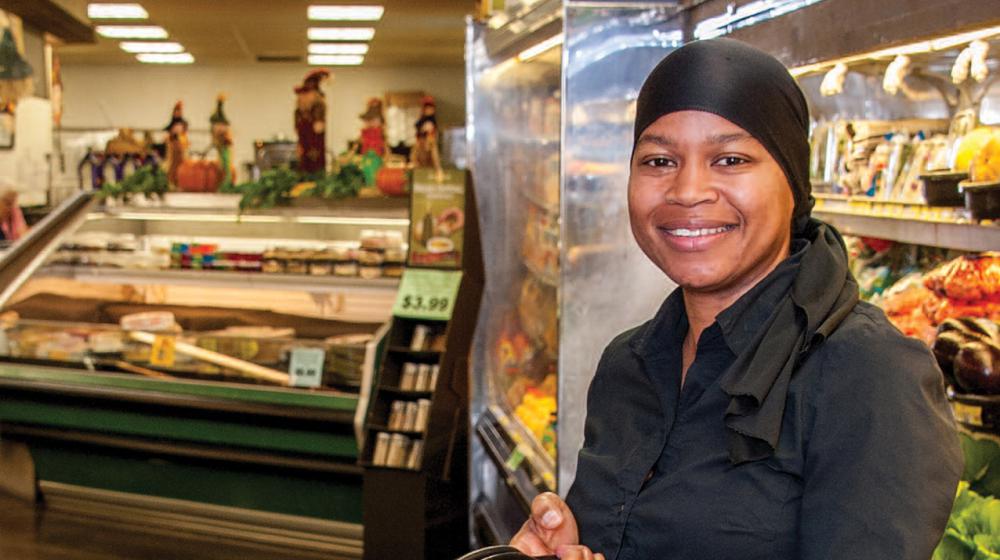Eating healthier, living better

Alberta Cheval, Extension EFNEP participant
With a business to run and five active children, Alberta Cheval never spent much time in the kitchen.
She often rushed through the grocery store, grabbing quick meals and snacks she knew her finicky eaters would like.
“I always thought eating healthy and exercising were overrated,” Cheval said. “I was an athlete in college, but, even then, I didn’t eat healthy.”
Three years ago, Extension’s Expanded Food and Nutrition Education Program (EFNEP) helped transform her family’s lifestyle. Now she and her five children— Breanna, Tia, Ruddie Jr., Tyrus, and Elijah—eat healthier and exercise more. EFNEP provides hands-on nutrition and health education to families to help them make healthy choices.
“Before going through the program, we ate a lot of prepackaged and ready-to-heat frozen foods,” said Cheval, whose children range in age from 8 to 17. “My children really didn’t like vegetables. They would say, ‘Mom, I don’t want these vegetables.’”
With help from staff at the Jones County Extension office, Cheval changed her whole family’s attitude. Ida Knight and Deborah Evers, both Extension program assistants, worked with Cheval and her children to educate them about how to make more nutritious choices.
Cheval studied the Making Healthy Choices curriculum on her own and met periodically with Knight, who came to her home and helped her learn new recipes and how to make better choices at the grocery store.
“We never used to pay much attention to what we ate,” Cheval said. “Now we buy a lot of fresh fruits and vegetables and check the nutrition labels on products. We watch our sodium intake, and we try to monitor the amount of calories and cholesterol that are in our foods.”
Evers supplemented the in-home education program with Kids in the Kitchen and Junior Chef, both hands-on nutrition programs aimed at young people and delivered at the Extension office. The programs focus on teaching children how to use the USDA MyPlate meal planner to choose nutritionally balanced snacks and meals.
Both programs allow children to prepare snacks and meals with fruits, vegetables, and other healthy foods. Each lesson teaches participants about the five food groups, the nutrients each group provides to the body, and why those nutrients are important for the body. The curriculum also teaches proper identification and uses for kitchen equipment and basic kitchen and food safety.
“The great thing about Kids in the Kitchen and Junior Chef is getting children involved in the kitchen,” Evers said. “If kids will get in there and participate in food preparation, they will at least try new foods that they don’t think they like.
“I had a child in one class who thought he didn’t like vegetables, but, once he helped prepare them, he tried them. We paired a few fresh vegetables with ranch dressing, and he liked it,” Evers said. Sometimes it is all about presentation, Evers said.
Cheval has learned to disguise a few things her children are not fond of on their own and lets them help make meal choices.
“I blend some of the vegetables in with other foods so they are more appetizing for them,” Cheval said. “I sometimes take them to the grocery store and let them choose the fruits and vegetables they want. I get them in the kitchen and let them help. We make it fun. If they prepare it, they will eat it.”
The Expanded Food and Nutrition Education Program also emphasizes food resource management by teaching participants how to maximize their food budget. Cheval said the program taught her how to comparison shop, which has saved her money.
“Now, instead of just grabbing something off the shelf, I know I can get more for my money by looking at the price per unit,” Cheval said. “It takes me a little bit longer to shop because I want to make sure I pick the right foods.”
The family also committed to regular exercise, which has brought them closer and improved their quality of life.
“We get outside and walk about four miles at least three times a week,” Cheval said. “We also play basketball and football in the evenings after school and work. We really enjoy that time together. The whole family feels better, too. I used to feel sluggish, but now I have the energy I need to get through the day. And I’ve seen that in my kids.”
Cheval said her goal is to teach her children how to live a healthy lifestyle.
“I want this learning experience to continue through future generations of our family,” she said. “My children have learned a way of life they can instill in their children.”


